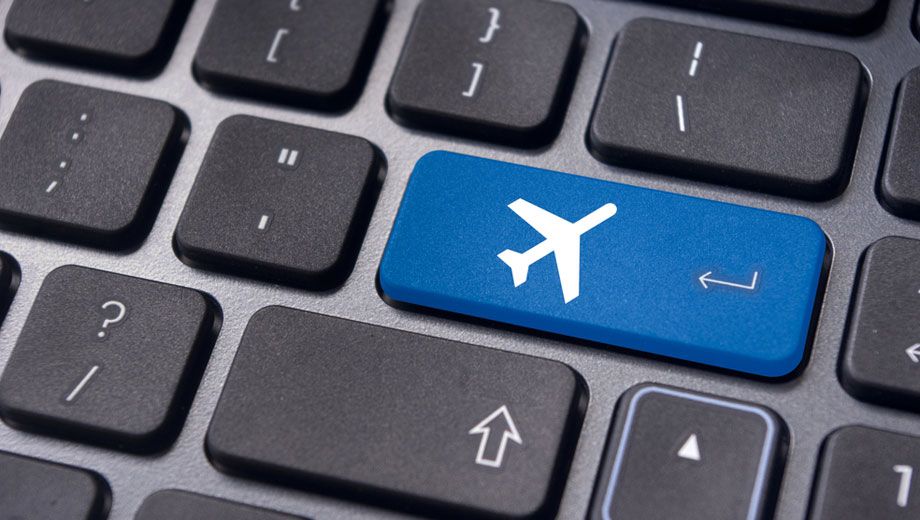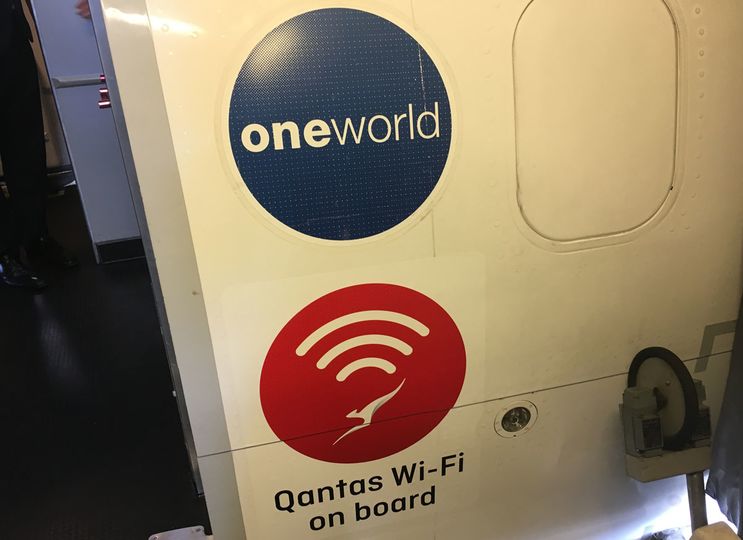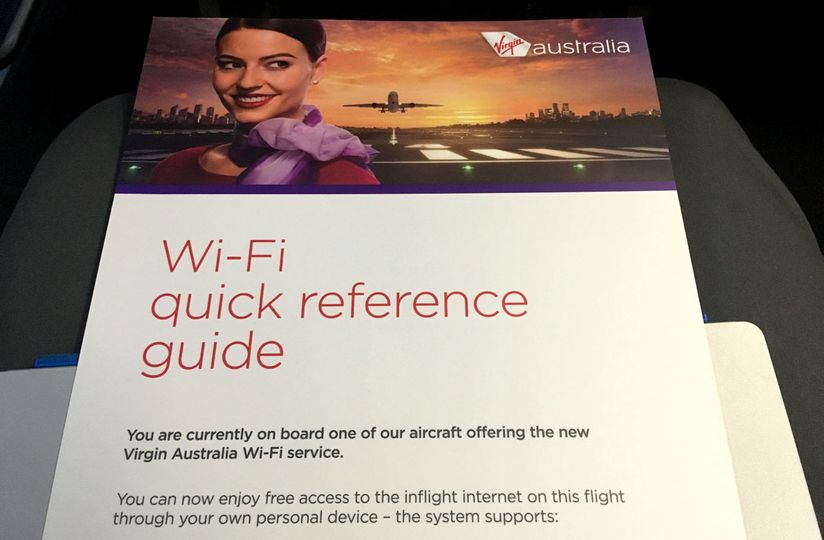Qantas vs Virgin Australia: how their inflight Internet compares

Inflight Internet has become the latest battleground in the dogfight between Qantas and Virgin Australia.
Both airlines now offer free sky-high WiFi – admittedly onboard a single aircraft – as part of a three-month trial of their respective technologies, ahead of a rollout to the rest of their domestic fleets beginning in the second half of 2017.
Australian Business Traveller has tested the inflight Internet services of both Qantas and Virgin Australia, and here's how they compare.
Availability
Qantas and Virgin Australia are each running their trials on a single Boeing 737-800, which is the workhorse of each airline’s domestic fleet.
For those who care for such things, the Qantas jet is registered as VH-XZB; Virgin's test aircraft is VH-YIG.
These WiFi-equipped Boeing 737s will mostly zip along popular east coast routes between Sydney, Melbourne and Brisbane, also known as the 'triangle', but with possible forays to regional centres and further afield including Canberra, Darwin and even Perth (where Internet access could prove especially useful during those five or so hours in the middle of the working day).
However, there’s no way to know in advance if your Qantas or Virgin flight will be on the WiFi jet before you book. It’ll depend entirely on how those jets are shuffled around the network from one airport to the next.
That said, you can see the airline's proposed next-day schedule for the WiFi jets, as well as get an idea of which routes they've been on over the past week: click here for Qantas' VH-XZB, and here for Virgin's VH-YIG.
If you happen to get lucky and score a ride on the Qantas or Virgin Australia WiFi jets, you'll know because the cabin crew will make an announcement upon boarding and prior to take-off.
Qantas also has a large red logo next to the aircraft door as you step on board (below) and will play a WiFi information video over the inflight entertainment system...
... while Virgin Australia has prepared an information card which can be found in your seat pocket.
You can connect to the Qantas WiFi hotspot and start your surfing as soon as you set onto the aircraft; with Virgin, just be a bit more patient and wait until the last aircraft door has been closed.
(Once the crew advise that it's time to switch your device to flight mode, you can activate WiFi and jump online.)
Technology
Although Qantas and Virgin Australia will both use satellites to keep travellers connected above the clouds, each airline has adopted a markedly different approach.
Qantas sprang for the NBN Sky Muster satellite system, which uses the relatively new high-speed Ka band, and has partnered with ViaSat.
Virgin Australia is hooked up to a fourth-generation Optus D2 satellite running on the older Ka band, but uses a special '2Ku' technology from partner GoGo to effectively double the signal throughput.
Speeds
While you can expect a war of words – or rather, numbers – between Qantas and Virgin Australia on who offers the best tech with the fastest connection, our initial testing indicates you can expect an average rate of 10-15Mbps to your laptop, tablet or smartphone on either airline.
That's as quick as most home broadband connections, making it plenty fast enough for streaming Netflix in HD (although I question the need for high-def on small laptop, tablet and smartphone screens compared to your massive wall-mounted home telly).
As a result, anything less demanding than streaming HD video – from web browsing and social media to fetching large email attachments and downloading files from cloud-based services such as DropBox – is completely do-able.
Here's the caveat: as the months go by, more and more passengers on these jets will be jumping online and claiming their share of the limited bandwidth available to each aircraft (in much the same way that several members of a family have to share a single home Internet connection).
As a result, you'll see more reports of these real-world experiences and get a better idea of how the systems stack up on a plane full of connected travellers.
And as more jets in the Qantas and Virgin fleets are upgraded with this satellite tech, we'll also know how well each of the systems scales to handle an exponential growth in users.
It's also important to note that unlike your hard-wired home or office connection, the speed of inflight Internet swings up and down to reflect each passenger's activities.
Somebody on a news website or reading their email will see their connection temporarily idled so that additional speed can be handed to passengers watching streaming video or downloading a large email attachment.
That's why it's important to consider overall speed rather than brief bursts and peaks.
And our take on this is that the best Internet speed isn’t a raw number – it’s not 10Mbps, 15Mbps or even 20Mbps.
The best speed is simply "fast enough" for whatever you want to do: be that web browsing, email, social networking or streaming music or video.
If it’s fast enough and reliable throughout the flight for every passenger, the numbers themselves are largely meaningless.
Pricing
During these trials, which are expected to wind up by end of July, Internet access is free on both the Qantas and Virgin Australia jets. So what happens after that?
Qantas has already declared that it will continue to offer free Internet as the service is expanded to the rest of its domestic Boeing 737 and Airbus A330 fleet; the airline has also ruled out a two-tier 'slow for free, fast for a fee' system.
Virgin Australia has yet to announce its pricing policy but is likely to let travellers choose between two levels of service: a 'basic' connection suitable for Web browsing, email and social media, and a 'high-speed' pipeline for streaming video from the likes of Netflix.
Virgin has also offered some hints as to how much it's likely to charge: a survey sent to selected Virgin Australia passengers in March pitched a basic connection at $8-$14 per flight with the high-speed alternative at $15- $21 per flight.
However, the survey allowed that “on some flights the price could be free, or the first 30 minutes could be free"; Australian Business Traveller has also been told that Internet access could be free for business class passengers and Velocity Platinum frequent flyers.
What's next?
After the public trials finish in July, each airline and their respective technology providers will rely on real-world usage patterns and passenger feedback to finalise the package to be installed onto the rest of their fleets.
That fleet-wide upgrade will be a long process, given the number of aircraft involved.
Even so, don’t expect it to be on every flight. For example, Qantas has yet to decide if it will outfit the smaller QantasLink regional jets such as the Boeing 717 and Bombardier Dash 8 Q400s.
Qantas and Virgin Australia will also focus first on their domestic routes before adding overseas flights into the mix.



18 Nov 2013
Total posts 46
I often find myself on QantasLink planes so wi-fi would be a very welcome addition to those flights which have no in-flight entertainment other than a magazine. These flights can be longer than any flight on the SYD/BNE/MEL triangle.
04 Nov 2012
Total posts 212
Please tell me phone calls can't be used on this new service.
Qantas - Qantas Frequent Flyer
02 Jul 2011
Total posts 1377
Already blocked on QF (at least mostly, reportedly some services still work)
QF
11 Jul 2014
Total posts 971
Hopefully they will roll out quickly, if Qantas had a flight with and Virgin didn't I would probably go Qantas so I could get work done. After making sure the Qantas flight wasn't actual a Jetstar flight.
09 Apr 2017
Total posts 12
I am usually happy to have the excuse of a flight to avoid emails, calls etc so I will be a reluctant adopter I suspect.
And I think you are right David, speed is only relevant if you are getting major buffer breaks that thwart your viewing. If the site load or refresh time is a little longer up there, so what?
And oh yes, ban voice calls. Apart from my brother, who mumbles at the best of times, everyone (myself included) seems to amp up the db's when talking on a mobile, on Skype etc.
Hi Guest, join in the discussion on Qantas vs Virgin Australia: how their inflight Internet compares